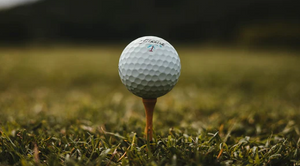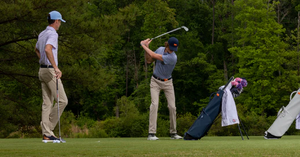How to Make Short Putts Every Time
We’ve all experienced the frustrations of missing short putts. Perhaps, you’ve navigated through the hole well, and all that’s left is to convert that last putt. Missing it can be heartbreaking and downright disappointing when you thought you’d shoot under par.
This guide will tell you why you’re struggling with short putts. Read on for practical tips to improve this area of your game.
Why Do I Struggle With Short Putts?
If you’re struggling to convert on putts, it helps to know some of the most common reasons and how to fix them.
Most amateur golfers fail to aim their putter face in alignment with the hole. In fact, improper putter face alignment is one of the leading reasons golfers miss their short putts. It’s common for golfers to forget to aim at their target, meaning the chance of making short putts is slim.
There are many training aids out there that can help with putter face alignment. Some golfers use the lines on the golf ball, which allow them to aim while playing.
Another reason for failed putts is bad contact with your golf ball. When the putter face of your club hits the ball directly centered, it’s more likely to travel in the direction that the face is aiming. Making off-center contact toward the putter's heel or toe causes the face to twist at impact and the ball to fly at a different angle than intended. Thus, your distance control also suffers.
Poor ball positioning is often a common reason for failed putts. A ball position too far back or too far forward will affect the body lines, negatively impacting the putter path.
If the ball position is too forward, the putting path will move from out to in, which causes pulls and cut putts. The trajectory makes controlling distance on putts tricky due to inconsistent contact. A consistent setup routine is essential to locate the suitable ball position every time.
How Can I Improve My Short Putting?
Short putts don’t have to be a weakness in your game. Making shorts putts is the easiest way to lower your scores. Most golfers can solve their putting woes with practice. Follow these sure-fire tips to help you improve your putting skills:
1. Aim the Putterface
Your golf ball always travels in the direction where you’ve pointed the putter's face during the moment of impact. The putter face should be perpendicular to your chosen line to keep it stable during the stroke without worrying about manipulating the face.
Where you aim the putter face is critical to making short putts. Always take a moment to align the putter face to the direction of the hole before gripping the club or establishing your setup.
2. Set the Golf Ball Near Your Front Foot
The ball should always be square to the line of your target, and your eyes should be directly over the ball. Keep your hands level, grip the putter lightly and let your arms hang loosely.
3. Get a Comfortable Grip
Getting a comfortable grip on the putter will stabilize the club and help you to deliver a square face during impact. Most grips feature a flat top, so you’ll want to place your thumbs there.
Most golfers use a reverse overlap grip, so the wrist doesn’t break during the stroke. Beginners may use a baseball bat grip holding the club in all ten fingers.
Experienced golfers will position their thumb of the bottom hand pointing to the ground. Also, place the index finger of the top hand over the fingers of your bottom hand.
4. Decide Aim
Your aim is critical on short putts. You’ll need to consciously decide on the direction in which you want to hit the ball.
The three areas to aim for are the edge, outside the hole, or the center.
You’ll almost always want to hit it center for a short putt and rarely have to aim outside the hole. Simply focus on nailing your aim point and hitting the line.
5. Check for Alignment
Golfers typically draw a straight line on the ball, helping them align it to the hole. This marking helps the golfer perform more accurate hits.
Also, evaluate the alignment of your body. Make sure to bend from the hips and not the knees.
6. Read the Green
Examine the grass along with the distance between the ball and the hole. Reading the green helps determine how much is needed to convert the putt.
For instance, a golfer may look for contours that may cause the golf ball to veer to the right or left. Another reason for reading the green is considering the shine of the grass. If you’re playing on Bermuda grass, the shine indicates the ball will likely roll fast. If the ball is on a slope, it’ll also move faster than usual.
Frequently Asked Questions
Should You Hit Short Putts Soft or Firm?
For most golf players, hitting the ball somewhere in the middle should be preferred since this ensures enough speed for the ball to reach the hole but also prevents the putt from going too long.
While hitting the ball softly sounds ideal, there may be some inconsistencies in the golf patch surrounding the hole, making it hard to predict. Conversely, while many golfers like Tiger Woods have perfected the firm short putt, some disadvantages exist. Hitting the ball more firmly increases the odds that it can lip out since it travels faster, which can slingshot the ball around the cup.
Final Thoughts
While putting is often deemed the easiest stroke in golf, many golfers still struggle to hit short putts due to their distance control. A lack of ball position, poor putter face alignment, and off-centered hits often causes this. Improving your putting technique can go a long way to hitting short putts and getting better scores.
The right equipment also goes a long way to help you convert more short putts. Shop for a quality putter cover and golf bag from Stitch Golf. Once you’ve got the perfect setup, go to your local club and start hitting some balls!



